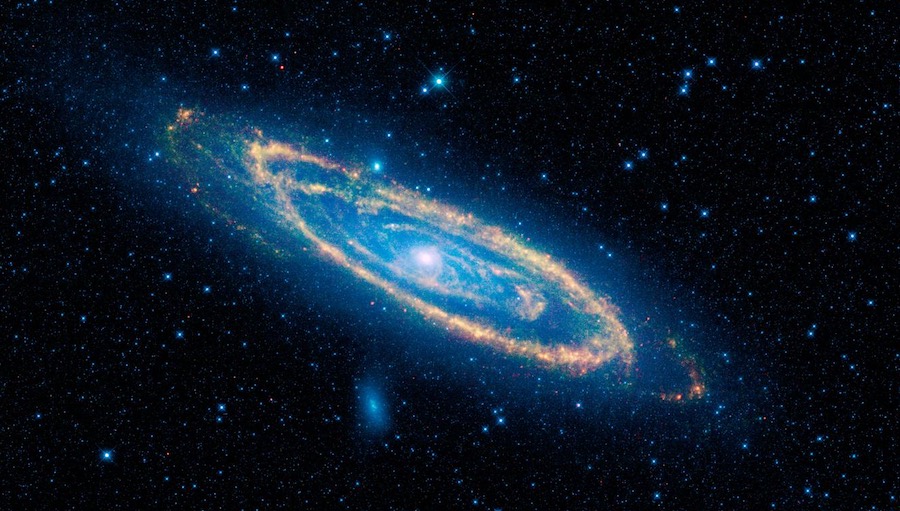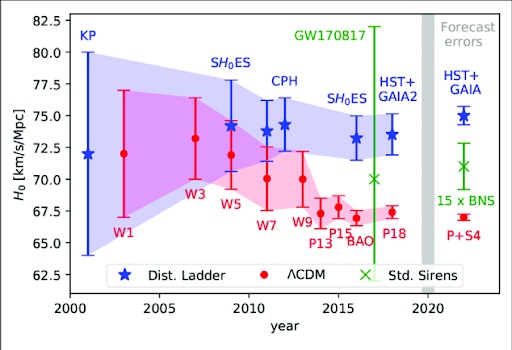Uncovering the Truth Behind the Crisis in Cosmology
It all goes back to Einstein.
Throughout history, humans have been fascinated by the marvels and mysteries of the night sky. For almost a century, however, modern Science has offered an explanation for how it came to be, beginning billions years ago. In the late 1920s, the Big Bang model emerged based on two key pieces of evidence: observations indicating an expanding universe and the mathematical framework supporting this expansion. The model’s prediction of residual radiation received apparent confirmation with the discovery of the Microwave Background in the 1960s.
Recent findings from the James Webb Space Telescope (JWST), however, present a different narrative. Scientists are grappling with the significant disparities between these latest observations and established theory. Could the Big Bang hypothesis be flawed?
The mathematical foundation of the Big Bang are rooted in Einstein’s theory of general relativity. This website is a library of scientific papers, books, articles and websites that specifically expose the problems with Einstein’s Relativity.
Fresh data has underscored the substantial gap, spanning decades, between our observations of the night sky and the dominant theory explaining its origins. Some of the glaring discrepancies between observation and theory have been described as a ‘crisis’ in the field of cosmology.
To work out where things went wrong, we need to take a closer look at the history of the current theory. How did the ideas develop over time, and what evidence was used to support them? As we shine a light on the foundations of the standard model, we find that reinterpreting the evidence can revolutionize our understanding of the universe. Not only that, the alternative interpretation is a much better fit for the data.
The story of the crisis in cosmology begins in 1924.

Andromeda Galaxy | Source: britannica.com
The story of the crisis in cosmology begins in 1924, when astronomer Edwin Hubble, with help from Henrietta Leavitt, first measured the distances to some of the brightest stars in the night sky, known as cepheid variables. By the end of 1924 he had found a dozen cepheid variables in the Andromeda Nebula (now known as the Andromeda Galaxy) using the 100-inch telescope at Mount Wilson Observatory. Hubble’s paper, published in 1925, demonstrated that the Andromeda galaxy was actually located far beyond the Milky Way and thus was a separate galaxy.
A few years later Hubble published a paper showing that the distances to these celestial beacons were directly proportional to the amount of energy carried in their light. The further away a star was from the Earth, the less energy its light carried, evidenced by its lightwave frequencies shifting towards the red end of the visible spectrum. This feature of starlight was called redshift and could be explained in two ways: (1) the wavelengths were spreading out due to Doppler effect caused by the star itself moving away, or (2) a loss of energy due to the light interacting with matter on its way to Earth. Debate raged in the 1930s and ’40s over which of these interpretations was correct.
Given that only redshift was observed from distant stars and galaxies and not blueshift as seen in our local galaxy, most astronomers concluded that all other galaxies must be moving away. Thus, the universe was thought to be expanding, and the Big Bang story of the universe’s origin was born. This expanding universe view also corresponded to one of Alexander Friedmann’s 1922 solutions to Einstein’s general relativity field equations, providing a mathematical basis for expanding spacetime.1 More evidence was demanded however, until another discovery by astronomers in the late 1960s appeared to hand cosmologists the so-called ‘smoking gun’ of the Big Bang. This was the Cosmic Microwave Background (CMB), deemed to be the radiation left over from the formation of the early universe approximately 13 billion years ago. The properties of the CMB were considered to carry the signature of an expanding universe.
Technology improved, more precise measurements were made.

Hubble Tension
Since the 1960s, however, as technology improved and more precise measurements were made, the conflicts between observed data and predictions of the standard model only got worse, not better. With every clash between data and theory, Cosmologists have had to modify the standard model by adding a new ad hoc justification. For example:
- The Horizon Problem (1980s): How can the entire universe share essentially the same temperature, even in regions too distant to have exchanged heat? Answer: In its infancy, the universe must have expanded at a very high rate (cosmic inflation).
- The Dark Matter Dilemma (1970s – present): Observations of spinning galaxies and clusters of galaxies indicate there is more mass in these systems than can be accounted for by visible matter (stars, gas, etc.). Solution: ‘Dark Matter’ must exist, an elusive substance that defies detection yet somehow holds the cosmic dance of galaxies in its gravitational grip.
- The Dark Energy Enigma (late 1990s – present): Observations of distant exploding stars (supernovae) reveal that the universe’s apparent expansion is accelerating (rather than slowing down as would be expected due to gravity). Solution? ‘Dark Energy’, a mystical cosmic force driving the universe to expand at an ever-accelerating pace against the gravitational pull of matter. The prime candidate for dark energy was Einstein’s original fudge factor, the cosmological constant, Λ.
In 1990, the Hubble telescope was launched to measure the expansion of the universe (the Hubble constant). As Hubble gave us more precise observations of cepheid variables in distant galaxies (despite its namesake, who had serious doubts about an expanding universe), the new data only led to an even more significant disparity with values determined by measurements of the CMB. The problem of having two different values for expansion rate derived from the two different measurement methods is called the Hubble tension.
In 2021, the JWST was launched to view objects too old, distant, or faint for the Hubble Space Telescope. The goal was to detect objects so distant that their light would’ve taken 13 billion years to travel to JWST. By observing the formation of these ‘first’ stars and galaxies, scientists hoped to see the ‘Let there be light’ moment. But data from the JWST has only made the problem worse.2 Not only did it not resolve the Hubble tension, the new images did not show young galaxies but revealed very mature galaxies that ‘shouldn’t exist.’ To account for the unexpected mature galaxies at the edge of the universe, astrophysicists quickly proposed more ad hoc fixes to keep the standard model of cosmology alive. These included increasing the galaxies’ formation rate,3 pushing back the date of the Big Bang,4 and even halting the universe’s expansion.5 But these improvised solutions were not strongly evidence-based, and only served to highlight the inescapable rift between predictions of the Big Bang model and actual observations.6 It was becoming increasingly apparent that there was something fundamentally wrong with the ΛCDM (Lambda Cold Dark Matter) standard model of the universe.
What if spacetime was not our best description of gravity?
What if we rewound the clock a hundred years and adopted Hubble’s preferred interpretation of redshift as simply a measure of lost energy, rather than recessional velocity? In this non-expanding universe model, would we still expect to find starlight redshift in direct proportion to distance? Several contemporary astronomers and cosmologists have presented strong evidence to support this view. Investigate the research done by Hubble’s student Halton Arp, and his student Eric Lerner for details. In addition to predicting the presence of mature galaxies before the JWST found them, Lerner’s static universe model also matched observations in regard to the angular size and observed brightness of galaxies:
‘In an expanding universe, the angular size of a galaxy should shrink by the redshift to the fourth power whereas, in a non-expanding one, it should just shrink linearly with redshift. What do we see? We see that angular sizes shrink linearly! In fact, if the sizes obeyed the fourth power law, we would hardly be able to see distant galaxies at all.’7
And what if the CMB was radiation generated in the present time, rather than dispersed from an event 13 billion years ago? Thanks to the groundbreaking work of Pierre-Marie Robitaille, there are groundbreaking arguments to suggest that the Microwave Background is of terrestrial origin.
Upon examining all the evidence, one begins to discern the fragility of the current model. At the core of the standard model of the universe lies the mathematics of an expanding universe, rooted in Einstein’s theory of general relativity. TGeneral Relativity elucidates gravitational attraction as the curvature of spacetime, an abstract characteristic inherent to mass itself.
But what if spacetime was not our best description of gravity? What if it turned out to be merely a mathematical construct? Are scientists believing in something that doesn’t exist? What about all the so-called proofs of general relativity such as its explanation for the orbit of Mercury, the deflection of starlight by the Sun, and the slowing of time with increasing gravity? And aren’t gravitational waves and GPS further evidence that relativity must be correct?
You’ll have difficulty finding the answers to these controversial questions in mainstream scientific journals. Artificial Intelligence won’t give away too much, either. Are you prepared to do some investigating and take a serious look at alternatives to the broken mainstream view? History has shown that for those who dare to follow the evidence, it can be a confronting but very worthwhile journey.
Those who can follow the evidence and let go of the consensus scientific view, will avoid being left behind in the coming paradigm shift. Welcome to EINSTEIN WAS WRONG.
Cosmology isn’t just about stars and galaxies; it’s about unraveling the very origin of our existence. Dive into this fascinating topic to find out why so many observations from space have clashed with prevailing theory over the past century.
A growing body of evidence suggests that modern Cosmology has taken the wrong path. To get back on track a paradigm shift is needed. It’s time to take a hard look at the validity of two foundational theories: Special and General Relativity.
We are arguably sitting at the forefront of scientific discovery, using the most advanced technology ever built, and yet it has only served to widen the gap between prevailing theory and observation. The divergence is staggering, causing many to wonder if the whole model is entirely wrong. The resources presented here argue that it is.
Measurements of the Hubble constant, calculated from cutting-edge space telescope observations of cepheid variables and Type 1a supernovae, are completely at odds with theoretical values derived from the Cosmic Microwave Background. What is the solution to this latest enigma? Evidence from reputable sources shows that the CMB is not as ‘cosmic’ as once thought. Explore the research published by Pierre-Marie Robitaille to discover the likely origin of this seemingly ubiquitous radiation.
Embark on a journey of discovery in tracing the current model of the universe back to Einstein’s Relativity. Explore the evidence with an open mind?